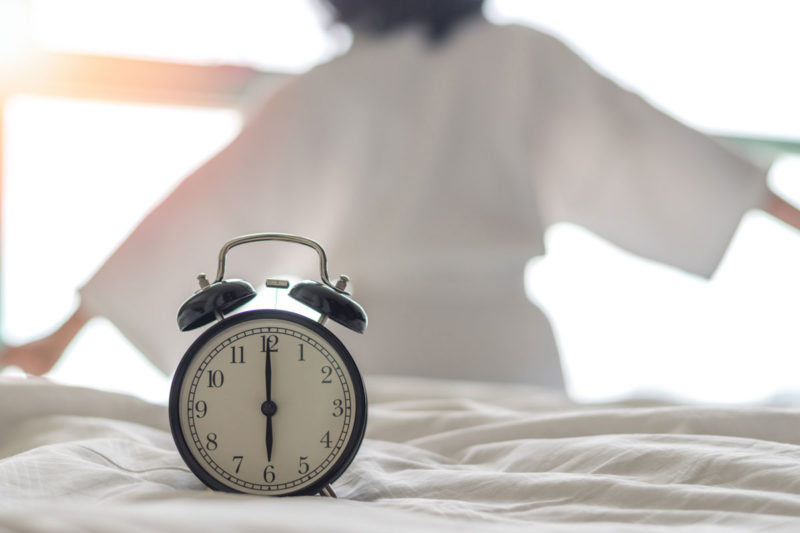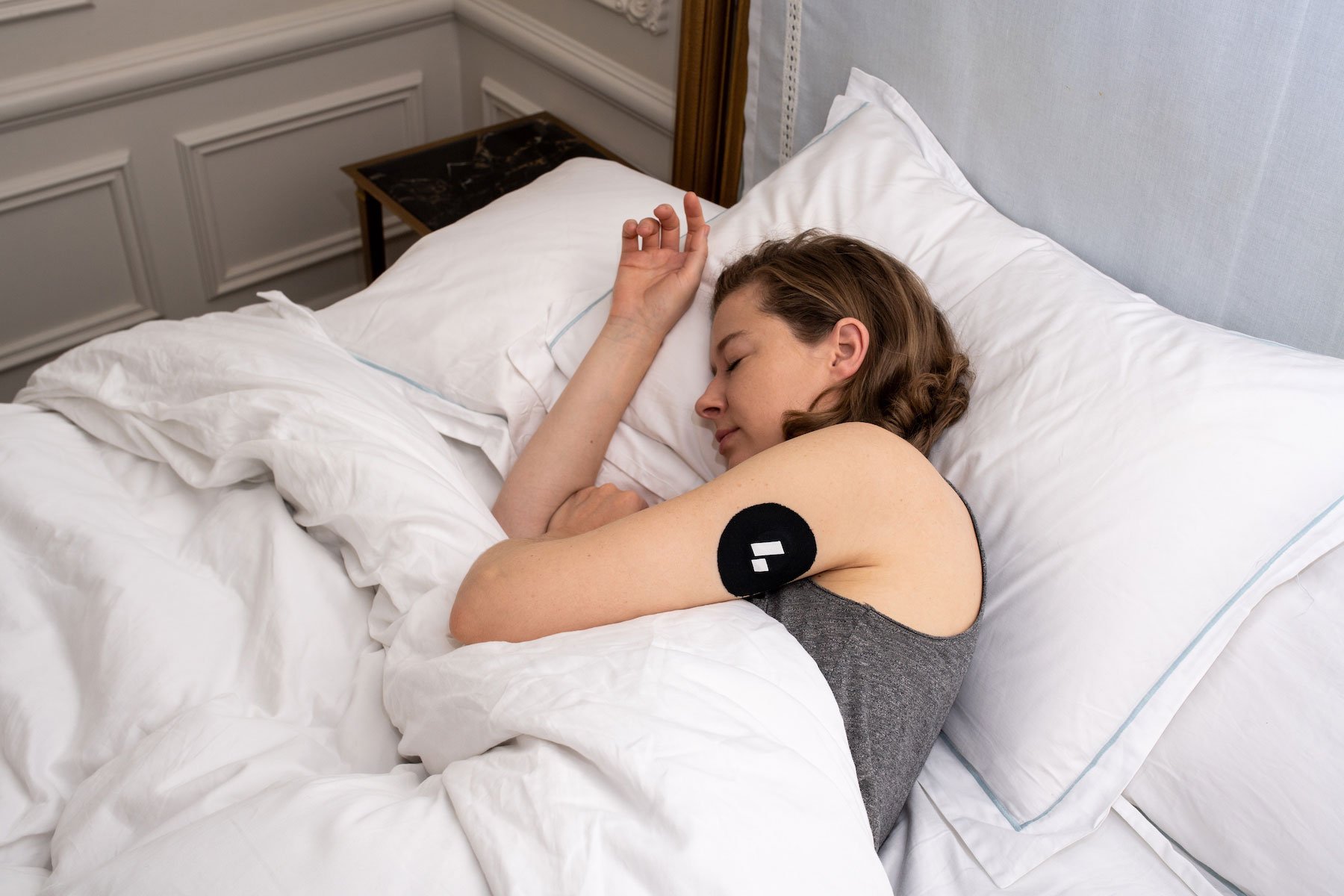Most of us know that the quality and quantity of our sleep affects glucose and insulin levels, as well as how effectively we produce and use that energy. When we don’t get enough sleep, those processes falter. But as with most systems in the human body, there’s a lot more to the story. When we go to sleep, when we eat our meals, and when and for how long we expose ourselves to light also matter. That’s because glucose metabolism is tied to our circadian rhythm—our internal 24-hour clock. And recent research has shown that outside factors such as late mealtimes, late-night light exposure, and irregular bedtime patterns can interfere at the cellular level, potentially leaving you with high glucose levels and reduced insulin sensitivity.
What is our circadian system, and how does it relate to glucose metabolism?
Our circadian system, or rhythm, runs in a roughly 24-hour cycle and is set every day by internal molecules and environmental stimuli such as light. When the cells in our eyes perceive natural light (and they can do so even when our eyes are closed), they alert the neurons in the suprachiasmatic nuclei (SCN), a tiny cluster of about 20,000 nerve cells located in the part of our brain called the hypothalamus that is the central timepiece for the circadian system.
From there, those neurons send signals that help regulate most physiological processes in our body, including the release of hormones to help us wake up in the morning and get sleepy at night, our body temperature, certain digestive secretions, and our glucose metabolism.
“Our built-in circadian clock seems to play a more important role in regulating glucose and insulin than our environment or behavior.”
Sleep and diabetes researchers have known since the 1960s that glucose tolerance and insulin sensitivity cycle throughout the day—meaning the same food could give us a higher glucose spike at night than for breakfast. But until relatively recently, it was unclear how much that pattern was driven by behavioral and environmental factors (most human studies had people sleeping at night and eating during the day) or whether that pattern is more governed by our endogenous circadian rhythm driven by light exposure.
People who don’t have diabetes will almost always see their best blood sugar control around mid-morning and watch tiher glucose levels get increasingly worse as the day goes on.
—Courtney Peterson, PhD
Several years ago, researchers at Harvard set out to answer that puzzle. To do so, they had healthy subjects eat breakfast at 8 am, dinner at 8 pm, and sleep at night; then in the second half of the study, they had them reverse the order, eating an identical breakfast at 8 pm, the same dinner at 8 am, with sleep happening during the day. The researchers, whose study was published in 2015, found that, regardless of when a participant slept or ate their meals, glucose levels kept shooting 17 percent higher—indicating lower glucose tolerance—in the evening (correspondingly, insulin levels were 27 percent lower in the evening than in the morning). Our built-in circadian clock seems to play a more important role in regulating glucose and insulin than our environment or behavior.
“What this and other research tells us is that, for people who don’t have diabetes, they will almost always see their best blood sugar control around mid-morning—it’s actually pretty good from about 5 am but peaks about four hours later—and watch their glucose levels start to get less good by lunchtime and increasingly worse as the day goes on,” says Courtney Peterson, PhD, associate professor in the department of nutrition sciences at the University of Alabama at Birmingham.
But while we now know that the SCN is the main player modulating our glucose metabolism, that’s not the end of the story. In the past three decades, researchers have also discovered that working along with our central clock are tiny genetic timepieces located in every organ and tissue in our body, each one also helping to drive our daily rhythms. As the authors of a 2019 review in the journal Nature Reviews Endocrinology explain, “the central clock regulates food intake, energy expenditure, and whole-body [glucose metabolism and] insulin sensitivity,” while the local peripheral clocks fine-tune all those actions. For example, “the peripheral clock in the gut regulates glucose absorption, peripheral clocks in muscle, adipose tissue and liver regulate local insulin sensitivity, and the peripheral clock in the pancreas regulates insulin secretion,” they go on to write.
While the SCN is triggered mainly by when we’re exposed to natural light, these peripheral clocks, though influenced in part by information sent from the central clock, are also set by behavioral stimuli: the time at which you eat along with your physical activity and sleep. Experts theorize that our metabolic health is optimal when the central and peripheral clock rhythms are in sync.
But that’s where serious issues can potentially arise. When we do things that knock these peripheral clocks out of time with the master one, your metabolism won’t know when to rev up or rev down, says Peterson. Studies have shown that when a circadian misalignment happens in humans, the result is decreased glucose tolerance; it is believed that ongoing misalignment could lead to insulin resistance and increase the risk of metabolic disorders like Type 2 diabetes and cardiovascular disease.
How throwing off your body clocks can lead to metabolic dysfunction
Researchers have narrowed the list of circadian disruptors down to three main factors: light exposure (getting too much at night and not enough during the day), irregular sleep schedules (due to social jet lag, jet lag, and shift work), and late-night eating. Sound like things you might do? You’re not alone.
With so many of us spending our days indoors at work, exposed to artificial light rather than more circadian-friendly natural light, and our evenings responding to social demands that often lead us to eat and drink late into the night, most of us, at some point or another, throw our clocks out of sync. Unfortunately, we’re doing it so much that a growing body of evidence points to “circadian disruptions” as one of the fundamental causes of the widespread rise of Type 2 diabetes and prediabetes worldwide. Some scientists now consider circadian rhythm disruptions a risk factor for Type 2 diabetes.
Scientists are still figuring out the exact mechanisms behind how these disruptions work, but the research is growing. Here’s some of what they know so far.
Light Exposure
Light is what sets our central clock in the SCN, so the timing of exposure and its intensity impact metabolic health. In one study of more than 100,000 women, exposure to light while sleeping was strongly associated with a higher BMI, waist circumference, and waist-to-hip ratio. Other research has found that increased exposure to light late in the evening is associated with increases in insulin resistance and glucose levels, with one study linking it to a 51% increase in diabetes in elderly subjects.
Exposure to bright light during the day also appears to be essential: When scientists in Brazil exposed obese women to bright light therapy (with an exposure equivalent to being outdoors on a cloudy day) three times a week for five months, they found a significant reduction in the subjects’ insulin resistance.
Researchers at the University of Geneva who are looking into the mechanisms behind these effects published a study in 2019 that suggests one possible pathway: They found that even a small increased or decreased light disturbance (an hour of light exposure in the middle of the dark cycle, or light removal for two days) is enough to profoundly influence the insulin sensitivity of tissues via specific neurons that are sensitive to light but also appear to be involved with the regulation of insulin sensitivity in muscles. As a result, insulin-induced glucose absorption is reduced. The alteration, however minimal, of this mechanism is sufficient to significantly disrupt metabolic homeostasis. This would help explain why people exposed to light at the wrong time are more likely to develop metabolic diseases such as diabetes, they concluded.
Irregular sleep schedules
Irregular sleep can mean not getting enough sleep (less than 6 hours), staying up past your usual bedtime and sleeping later than normal (social jetlag), or sleeping during the day and working during the night (night shift work).
“With social jetlag, you’re inducing these little micro circadian misalignments and confusing your circadian system about what time zone you’re in,” says Peterson. That has negative consequences for your blood sugar and can lead to metabolic dysfunction. Indeed, research has found that people 60 years or younger with social jetlag of greater than one hour—meaning the difference in time between when you usually go to bed and when you do on your days off, which includes 69 percent of the population—have more than 1.39 times the prevalence of prediabetes or diabetes compared with people with less than one hour. Similar associations are seen in shift workers and people who work late at night.
All three of these irregular sleep patterns have been linked with poor glucose control and insulin resistance, though the how and why is still unclear and likely multilayered. Some possible factors include:
- Reduced insulin sensitivity of fat cells: One small study showed that after getting less than 6 hours of slumber, even for just one night, those cells are less able to respond to insulin, leading to higher than normal blood sugar levels. The researchers observed one possible mechanism: The phosphorylation of Akt, a crucial step of the phosphatidylinositol 3-kinase (PI3K) pathway that mediates most metabolic actions of insulin, was markedly impaired after sleep restriction.
- Disrupted nutrient balance: The authors of that 2019 review in the journal Nature Reviews Endocrinology posit that circadian misalignment between the central and peripheral clocks—from, say, irregular sleeping patterns—may also cause disruptions in metabolic processes. For example, when glucose production, glucose uptake to the muscles, and carbohydrate intake are all off-kilter from one another, that misalignment could contribute to elevated levels of glucose and an imbalance of lipid levels, which can contribute to insulin resistance.
- Increased endocannabinoids: Another study found that subjects who went through four nights of restricted sleep (4.5 hours) had elevated levels of certain endocannabinoids—cell signaling compounds known to stimulate appetite—along with increased hunger and snacking the next day. They think that these compounds may be one of the pathways through which short sleep patterns lead to excessive food intake, obesity, and possibly metabolic disorders.
- Hormonal effects: Other research points to the fact that evening cortisol levels tend to be elevated in such conditions, and those elevations could contribute to insulin resistance. Melatonin, which also gets disrupted with irregular sleep, is likely involved.
Late-night eating
In studies, eating late at night has been associated with high blood sugar levels and insulin resistance. Much of that, researchers have thought, was because people who eat late at night also tend to consume larger portion sizes and calorie-dense foods that can lead to those issues. But regardless of calorie intake, the actual timing of when you eat appears to be just as important a factor.
“When you eat late at night, you’re eating when your body has already started to produce higher levels of the hormone melatonin,” says Peterson. “We know melatonin causes an increase in blood sugar levels because as the hormone increases in the body, it suppresses the release of insulin. So, if you’re eating when those hormone levels are elevated, your blood sugar control, which is already low, will only get worse.” There’s also some evidence, she says, that when people eat later in the day, they don’t burn as much fat—which can also leave you with higher-than-normal glucose levels.
“‘If you have meals at irregular times, that’s kind of the equivalent of putting all your body clocks through a metabolic jetlag.’”
Our peripheral clocks are also involved here, says Kristen Knutson, PhD, associate professor of neurology and preventive medicine at the Feinberg School of Medicine at Northwestern University in Chicago. “A major cue to many organ and tissue clocks is food intake. So, if you’re eating at a time that is not when your central clock thinks you should be eating, now you’re sending mixed signals to the rest of your body. Processes that are supposed to be either occurring simultaneously or not in tandem at all are now aligned in a way they’re not supposed to be, leaving your metabolism not functioning optimally.”
A study in mice suggests that these changes in circadian clock rhythms affect us at both the genetic and protein levels. While fed a high-fat diet, mice exposed to dim light at night gained more weight than their peers who were not exposed. The researchers found that nighttime light exposure decreased the expression of fundamental clock genes; these genes encode tiny messengers that help keep our internal clocks running correctly. This genetic disruption suggests a mechanism connecting circadian imbalance with weight gain.
The good news is that, despite not knowing the direct cause and effects, experts can say for sure that there are things you can do to help keep your body in sync and operating at its peak.
How to keep your circadian system in alignment and glucose metabolism optimal
- Try to eat all your meals during the day. A new clinical trial suggests that eating only during the daytime might prevent the higher glucose levels associated with the three circadian disruptions we’ve mentioned above. The researchers randomly assigned 19 healthy men and women to a 14-day simulated night work condition (late-night light exposure, irregular sleep pattern, and late-night eating) with one of two meal schedules: one group ate during the nighttime, while the other group only ate during the day. The researchers then evaluated the effects of these meal schedules and found that those who ate at night saw a 6.4% increase in their glucose levels, while those who ate during the day saw none. As the senior author noted, “This is the first study in humans to demonstrate the use of meal timing as a countermeasure against the combined negative effects of impaired glucose tolerance and disrupted alignment of circadian rhythms resulting from simulated night work.”
“Based on what we know so far about the circadian patterns of glucose and insulin, I tell all my patients that if they’re concerned about their metabolic health, they should ideally eat between 10 am and 6 pm,” says Sara Gottfried, MD, author of Women, Food, and Hormones. Or try to keep them between 8 am and 6 pm, she says, if the former feels like too tight a window. At the very least, “stop eating at least three hours before you go to bed,” says Gottfried.
- Make mealtimes consistent. “One leading hypothesis in the field right now is that eating meals at regular times is also really important,” says Peterson. Since our peripheral clocks are primarily set by when we eat, “if you have meals at irregular times, that’s kind of the equivalent of putting all your body clocks through a metabolic jetlag.”
- Keep to a regular sleep schedule even on days off. Try to commit to going to bed at the same time every night of the week and aim for 7 to 8 hours of sleep a night. “I often recommend using a sleep tracker, which can help remind you to start winding down for the night and also help you figure out what you might need to improve on to get a good night of rest,” says Gottfried.
- Get outdoors for at least an hour every day. “Getting doses of natural light in the first half of the day, ideally before, say, 4 pm, is best to get the kind exposure that will keep your central clock ticking in the right time zone,” says Peterson. While sitting by a window can help, she adds that light filtering through the glass won’t have the same effect as being truly outdoors. Try timing your exposure to a morning run or lunchtime walk since, as we know, exercise helps improve our glucose uptake.
- Establish a curfew on late-night light. “What happens over time is that if you don’t get enough bright light at the right time—during the day—or if you take it in at the wrong time at night, you’re weakening your circadian clock, and your body ends up not knowing whether it’s daytime or nighttime,” says Peterson. Blue light from electronics is included in the curfew. “Since we know blue light can impair glucose tolerance, I advise patients to turn off their screens at least one to two hours before they go to bed,” says Gottfried. Keep all lights off in the bedroom, and don’t allow hallway or other ambient light to filter in (if street or city light outside your window is an issue, consider investing in blackout shades or curtains).







